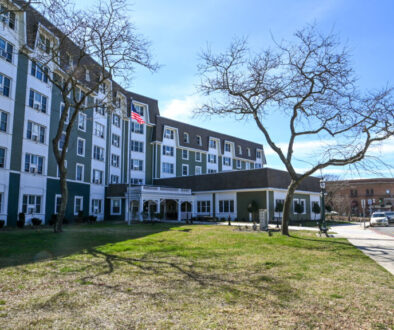Old Charm in a New World
For those of us who’ve lived through the advent and normalization of all things internet, we may think of “smart homes” as stark, futuristic environments not completely unlike Stanley Kubrick’s cinematic masterpiece, 2001: A Space Odyssey, in which an AI persona named Hal goes dangerously haywire. We would, of course, be wrong. Smart homes, while reliant on the interconnection of household devices through an online network, aren’t malevolent—they are, in fact, hugely convenient, providing homeowners with the ability to manage specific tasks like lighting, security, heating, and more with the touch of a button or two. And they are more popular than ever.
With their popularity, however, comes a design dilemma: how can we integrate technology, which seems to reign supreme, with personal preferences like antiques, when it seems like a clash of the epochs? We spoke with Katie Rementer of Cedar Mill Lane, who is adept at handling this type of juxtaposition. She’s seen firsthand that even as we move forward on both technology and sustainability, we seem to hold on to elements of the past, particularly statement or nostalgic pieces. For Rementer, designing for the future isn’t about replacing the past, but intertwining it with the present to create spaces that are aesthetically pleasing but rich with history and personal significance, with an emphasis on old charm.


“I would consider old charm anything that has a story, history, or personal value associated with it,” says Rementer. “Creating a space that is full of intent, comfort and conversation starters are really at the heart of making a house a home.”
Incorporating antiques into modern living spaces is more than a décor preference–it’s about infusing a home with soul and character. As Rementer puts it, it’s like finding a dress that looks great but also has pockets(!), making it both functional and delightful.
Of course, the road to seamlessly blending antiques with the technology of today isn’t without its challenges. It takes creativity, ingenuity, and a level of expertise to make a space both smart and interconnected as well as warm and inviting. Rementer acknowledges that some items can pose particular predicaments.
“Some of the more difficult items to integrate into an antique aesthetic are things like televisions, routers, modems, smart devices like Echos, thermostats, and that mess of chargers and cords we all have for the 85 smart devices we have somehow acquired,” Katie says.
For regular homeowners, these challenges could lead to an endless mess of cords, wiring, and unsightly stacks of consoles and gaming devices. Pros like Rementer find ways to disguise, hide, and camouflage all the things that make a smart home function. Take, for instance, Rementer’s ongoing battle with thermostats, a battle she says she’s yet to win.


“Thermostats need to be in a free air flow environment so they can accurately read a room’s temperature, humidity, and the like, so covering them with fancy faceplates will likely only result in, at best, your discomfort and at worst, a costly visit from your HVAC technician,” says Rementer. “So, while those thermostat covers you find on Pinterest look cute, please avoid them. They’re never a good idea.”
Instead of hiding thermostats, a tactic used for other smart devices, Rementer suggests camouflaging them with strategically placed frames or gallery walls. This offers a creative solution and conceals the unsightly but also transforms the area into an artful element of the room.
Televisions, another common eyesore in modern homes, also benefit from Rementer’s innovative treatment. In particular, she suggests the Samsung “Frame” television for its ability to seamlessly blend into a space thanks to its slim profile and customizable display options.
“The Frame has, in the simplest of terms, removed the majority of the television’s internal elements and equipped them in an external component box. This is what makes the Frame so extremely thin that it can lay almost entirely flush against the wall it’s mounted on, with little relief. She’s a pretty penny, but as a Frame owner myself, it’s absolutely worth it,” says Rementer.
Televisions are just the tip of the iceberg when it comes to smart design. In fact, kitchens are one of the biggest victims when it comes to sacrificing style for technology, since futuristic appliances don’t necessarily reflect the design of an antique, bespoke kitchen. And while companies like SMEG and Big Chill have reinvigorated the retro appliance scene, they don’t always offer the same amenities—namely, space—that their modern counterparts provide. Which is why Rementer suggests going another route for homeowners who require a large refrigerator.
“You can always opt for a panel-ready piece. From refrigerators to dishwashers and microwaves, panel-ready appliance options are out there, and they absolutely kick your kitchen aesthetic up a notch,” says Rementer. “Gone are the days of deciding between stainless, black, or white. Appliances matching your cabinets is the upgrade we never knew we needed.”
Covering things up is a fantastic strategy, but there are some setbacks: some of the items most in need of covering up require a cooling fan. Tight fitting facades can be dangerous in these cases. Likewise, other technologies require a signal to be received from a remote or gaming controller, so restriction is an issue.
“One of the more unique solutions I’ve seen for fan-cooled devices is the use of a pretty return or register cover,” says Rementer. “There are so many unique and vintage designs available, you would never guess what their intended purpose was. These covers, which are usually metal and have holes and openings due to their nature, are bent to the shape of a device—think of a hardback book cover over the spine and pages of a book. This creates a far more aesthetically pleasing option while also allowing for air passage to the fans, and remote signals remain unimpeded.”
Not everyone has the means—or the desire—to convert their existing home into a smart home. But there are some steps all of us can take to make our homes more efficient with little effort.
“An amazingly simple and often overlooked item to incorporate into antique spaces is smart light bulbs! The bulbs can be found in just about any corner of the internet or even your favorite big-box store,” says Rementer. “They can connect directly to your phone and other smart devices which give you the benefits of a smart home right inside your favorite bespoke lamp.”
For Rementer, there are some easy fixes to at least streamline the technological clutter. Take, for example, her own home gaming system, one you’d never know was there. “We are a family of gamers. One of the most surprising things you’ll find in our house is a completely concealed secondary television, gaming system, and a controller/headset charging station hidden in a glass door buffet mere steps away from our primary television set up,” says Rementer. “The trick to hiding something large and unsightly like a television in a glass cabinet? Painting the interior of the cabinet black so when it’s closed you have no idea what’s actually behind that glass!”
The key to starting the conversion to a smart home is to start small, with solutions you think you’ll need, rather than getting stuck on every bell and whistle out there.
“Not everyone needs to watch television on their refrigerator door or in their bathroom mirror,” says Rementer. “Sometimes all you need is a little creativity and ingenuity to make your home operate flawlessly from the sound of your voice or the touch of a button, without sacrificing what makes your house your home.”



